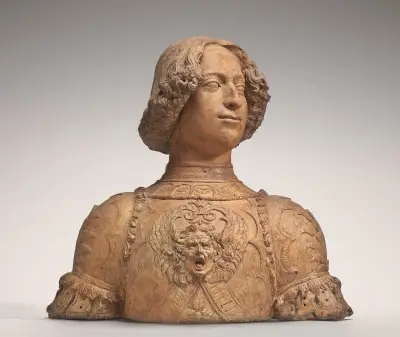Andrea del Verrocchio's arresting bust of Giuliano de' Medici, younger brother of Lorenzo the Magnificent, may have been commissioned for his coming of age in 1475.
The face exudes confidence and his expression is embracing life, ready for the joust that was to be celebrated in his honour. The statue was originally painted, and possibly once wore a metal helmet, but it's still a colourful portrayal.
Whatever the occasion, the exercise is a portrait in realism, perfectly expressed by employing the warmth of terracotta, together with rock and clay. In contrast, there is the sculptor's more idealised and distant Lady With Primroses, also known as Woman Holding Flowers, in the Bargello. Did the cooler and harder marble of the latter affect the style, or was it chosen to reflect what the sculptor wished to convey?
Giuliano's statue is dated at some time between 1475 and 1478, but in April 1478, he was unfortunately murdered during the events of the Pazzi Conspiracy, a failed plot to overthrow the ruling Medici dynasty. Verrocchio had become a favourite of the family after the death of their revered Donatello, and this is the period for which the artist is best-known. The patronage of Lorenzo and his son Piero, during the twenty years that led up to his death in 1488, enabled him to embrace a variety of styles, subjects and materials, such as those in this bust.
Not much is known about the early life and art of this son of a Florentine brick and tile maker, born around 1435, but another commission of 1465-83 confirms his talent and his willingness to experiment, which come together so movingly in the Giuliano piece. The Doubting of Thomas group, commissioned for the facade of Orsanmichele, drew great praise, and is considered one of the most significant of its type during the Renaissance, a triumph of the spatial positioning of two large high-relief figures, composed of hollow bronze shells.
Other early works were a bronze statue of a rather subdued David, and the highly-original sarcophagus for Giovanni and Piero de Medici in San Lorenzo. Surrounded by an arch of marble with porphyry and bronze, it features a grill fashioned as intertwining ropes, echoing the attention to detail that is lavished on Giuliano's sculpted tunic, thought by some to be modelled on his jousting uniform. Throughout his career, Verrochio seized opportunities to take on a variety of commissions in different cities, and to try fresh techniques, all of which are used so successfully in the life-like bust of Giuliano de Medici.
As a member of the Guild of St Luke, Verrocchio maintained a workshop in Florence, where great names such as da Vinci served time as apprentices. Painters like Botticini, Perugino and Ghirlandaio also passed through, making it sometimes hard to separate their work from that of Verrocchio. There are five paintings attributed to him, the best being the Baptism of Christ, when the master let his student Leonardo da Vinci work on both the head of an angel (the first to the left), and the vista beyond.
The bust of Giuliano de' Medici is now housed in Washington DC's National Gallery of Art, where, together with that of Lorenzo de' Medici by the same artist (at first wrongly attributed to Michelangelo), it forms part of the Florentine Sculpture Collection. The strikingly colourful finish on the restored Lorenzo piece may represent blood spilled during the Pazzi Conspiracy, when Lorenzo was also attacked. Developed in collaboration with wax specialist Orsino Benintendi, it again demonstrates Verrocchio's versality.
At the end of his life, Verrocchio opened a new studio in Venice to work on to his most ambitious project, a statue of the military leader Bartolomeo Colleoni, in which he rejected Donatello's posed mount and depicted the great soldier riding into battle. His continued willingness to adapt has left a lasting legacy still relevant today, and this bust of Giuliano de' Medici continues to impress.




